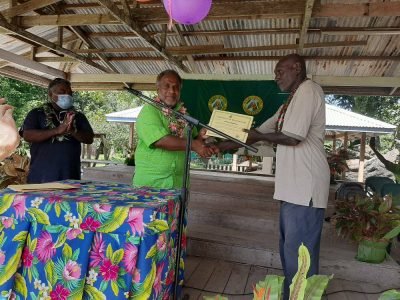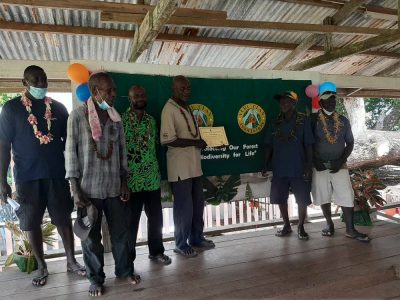Fifth Legal Protected Area declared in Choiseul Province
Vuri Forest Conservation Area in Babatana Ward, South Choiseul Province has become the 5th Legal Protected Area in Solomon Islands after receiving its certificate of registration on Wednesday.

MECDM Deputy Secretary Technical, Mr Chanel Iroi (L) signs and handover the certificate to Chief of Vuri clan association. Photos: Babatana Rainforest Conservation FB Page
A team from the Ministry of Environment, Climate Change, Disaster Management and Meteorology (MECDM) with Deputy Secretary Technical, Mr Chanel Iroi were present at the ceremony to officially sign and handover the certificate to the Chief of Vuri clan association.
Vuri is one of the six tribal groups working under the Babatana Rainforest Conservation Project (BRCP). All these tribes are located within the Babatana Zone with most people residing in Sasamuqa, Panarui, Boe, Sepa and Qome village in south Choiseul.
The BRCP aims to deliver enduring benefits to participating tribal communities through the provision of payments (compensation) for the loss of income from avoiding industrial logging.
It is designed to be a group project which gives tribal groups the opportunity to register and join the project where community governance systems can be strengthened to manage communities for carbon trading.
It will further enable the associations registered under them to manage carbon revenue in a manner that brings sustainable benefits for communities in the form of community development initiatives and through administering the distribution of member dividends.
For Vuri Clan, gaining its Protected Area (PA) status is just the beginning of its goal in conserving its forests while also benefiting from it.
In an interview with SIBC, Vuri Clan Project Coordinator Mr. Myknee Sirikolo says the idea to conserve their forests started way back.
“In 1948, our great grandparents conserved our forests through Traditional Forest Conservations. That is, when one of our great grandmothers passed on Vuri land, they decided to leave the forest as it is, and not to disturb it.
“From then on, the knowledge of conservation passed on to us to this day,” he said.
In 2008, the Vuri Clan decided to formally protect their area through government laws and policy. It was until in 2010 when the government launched the Protected Areas Act that they formally registered the Vuri land.
They were formally gazetted under the Protected Areas Act on 21st March 2022 coinciding with the International Forest Day.
With years of hard work in finally receiving their PA status this week, Mr. Sirikolo said they were also faced with many challenges.
“When we started in 2008, unfortunately there was no Protected Areas Act as it was enacted in 2010 and its regulations in 2012, so we struggled on our own as a community with the goal that we must protect our forests to sustain our livelihood and safeguard the future of our children through resource management.
“The longer it took for us to achieve the goals we wanted in benefiting from our protected forest, people began to doubt what we were doing, which was expected. But our chiefs and tribal elders remained strong minded that we finally achieved this after 13 years,” he said.
Mr. Sirikolo explains that the Vuri Clan has a total of 616 hectares of land from which they’ve allocated 578 hectares for conservation. The remaining land is allocated for land use properties such as gardening.
“One of our main aims for conservation is to join the Nakau Programme which focuses on doing forest inventory and measurements for carbon trading. Our rangers have already been trained, we have our inspector ready, and we have also done household consultations.
As of the coming week to July, fieldwork will be done to carry out the systematic recording of forest trees. This is to get data to find out how many tones of forest carbon our protected area has and how much its value is.”
Mr. Sirikolo says all the work done towards receiving the certificate of registration would not be possible if it weren’t for the help of the government and non-government organizations.
He thanked the government through the Ministry of Environment and the Ministry of Forestry for their support, with organizations such as NDRC, Live and Learn Solomon Islands and Ecological Solutions.
Currently, there are four tribal groups under the Babatana Rainforest Conservation Project which have been listed as Protected Areas, which are Sirebe, Siporae, Pandizaka and now Vuri.
For the country in total there are now five sites listed as Protected Areas, which includes Arnavon Islands Community Marine Conservation Area in Isabel Province.
With regards to carbon trading, Sirebe Tribal Association was also the first in the country to receive carbon payment from carbon, with an amount of over $300,000 received in quarterly payment earlier this year.
By Eliza Kukutu

